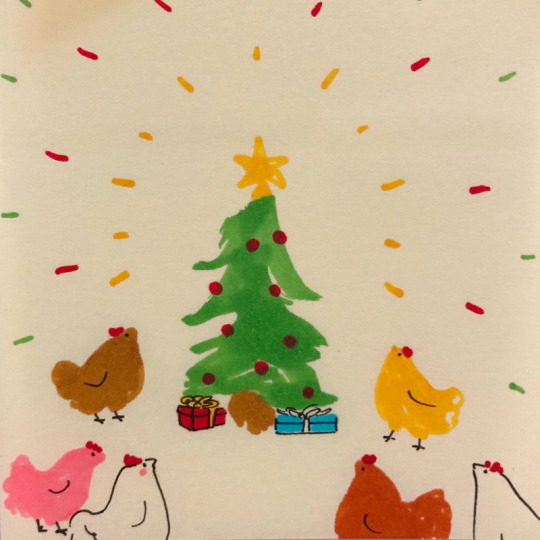Text

BAWKtober Day 10 - Harvest Moon
Tastes best gathered under moonlight
If you wanna support my october doodles (or buy a treat for my spoiled, spoiled chickens) my kofi and commission links are in pinned post~
150 notes
·
View notes
Text
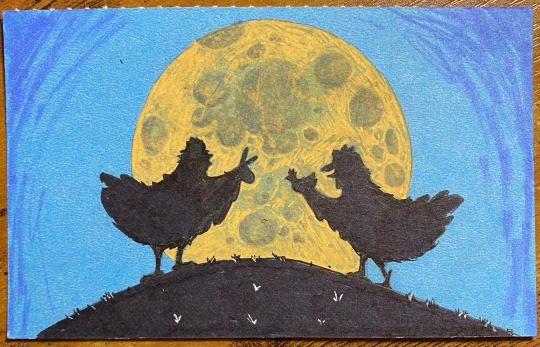
BAWKTOBER day 10: harvest moon
Another quick/low-effort piece but it still makes me chuckle a little.
@makenna-made-this
42 notes
·
View notes
Text

Catching up on my BAWKtobers so have a sneaky peeky
34 notes
·
View notes
Text


Beeper is mesmerized by the electric kettle.
461 notes
·
View notes
Text

BAWKtober Day 27 - Familiar
A thoroughly modern familiar!
Shhh if you see it's november now, no you don't. I'm hangin' in there til the end, even if we're a little late (ง •̀_•́)ง
If you wanna support my october doodles (or buy a treat for my spoiled, spoiled chickens) my kofi and commission links are in pinned post~
586 notes
·
View notes
Text
HORROR WEEK- FOTD #145 : death cap! (amanita phalloides)
the death cap (sometimes also stinking amanita or deadly amanita) is an agaric fungus in the family amanitaceae :-) it was originally widely distributed in europe, but was later introduced to other countries across the world. it forms ectomycorrhizal associations with broadleaf trees !!
the big question : will it kill me??
it will kill you SO BAD. you will BE SO DEAD. it is the most toxic mushroom currently known to science :-3
"the toxins of the death cap mushrooms primarily target the liver, but other organs, such as the kidneys, are also affected. symptoms of death cap mushroom toxicity usually occur 6 to 12 hours after ingestion. symptoms of ingestion of the death cap mushroom may include nausea & vomiting, which is then followed by jaundice, seizures, & coma which will lead to death. the mortality rate of ingestion of the death cap mushroom is believed to be around 10–30%."
the "most fun" part is, they're easy to confuse with many edible mushrooms.
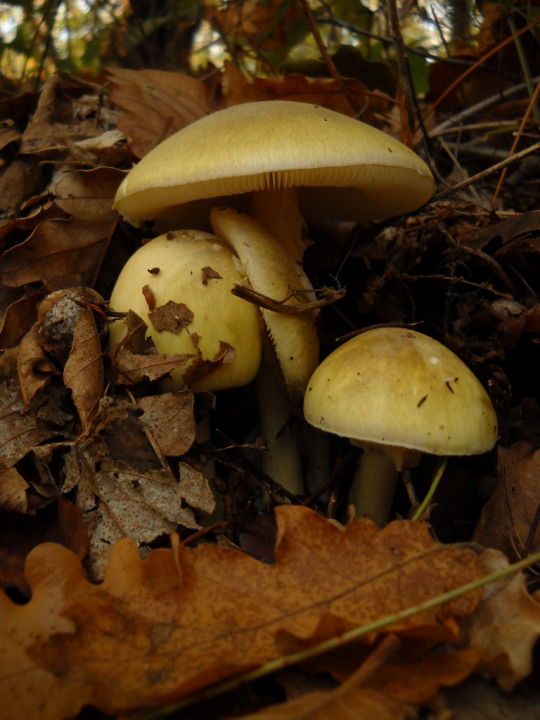
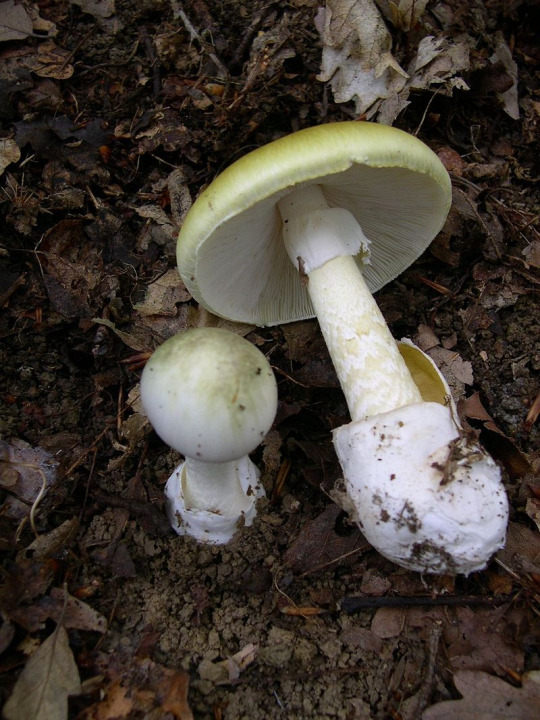
a. phalloides decription :
"the death cap has a large & imposing epigeous (aboveground) fruiting body (basidiocarp), usually with a pileus (cap) from 5 to 15 centimetres (2 to 5+7⁄8 inches) across, initially rounded and hemispherical, but flattening with age. the colour of the cap can be pale-green, yellowish-green, olive-green, bronze, or (in one form) white ; it is often paler toward the margins, which can have darker streaks ; it is also often paler after rain. the cap surface is sticky when wet & easily peeled—a troublesome feature, as that is allegedly a feature of edible fungi. the remains of the partial veil are seen as a skirtlike, floppy annulus usually about 1 to 1.5 cm (3⁄8 to 5⁄8 in) below the cap. the crowded white lamellae (gills) are free. the stipe is white with a scattering of greyish-olive scales & is 8 to 15 cm (3+1⁄8 to 5+7⁄8 in) long & 1 to 2 cm (3⁄8 to 3⁄4 in) thick, with a swollen, ragged, sac-like white volva (base). as the volva, which may be hidden by leaf litter, is a distinctive & diagnostic feature, it is important to remove some debris to check for it."
[images : source]
[fungus description : source]
"GUYS !! it's her<3 i love her so fucken much."
58 notes
·
View notes
Text
HORROR WEEK- FOTD #144 : apple bolete! (exsudoporus frostii)
the apple bolete (also frost's bolete) is a mycorrhizal fungus in the family boletaceae >:-) it typically grows near the hardwood trees of the eastern US, southern mexico & costa rica.
it was chosen for horror week due to its appearance being reminiscent of muscle tissue !!
the big question : will it kill me??
nope !! however, although they are edible, they are not recommended for consumption as it is quite easy to confuse them with other red boletes. ^^
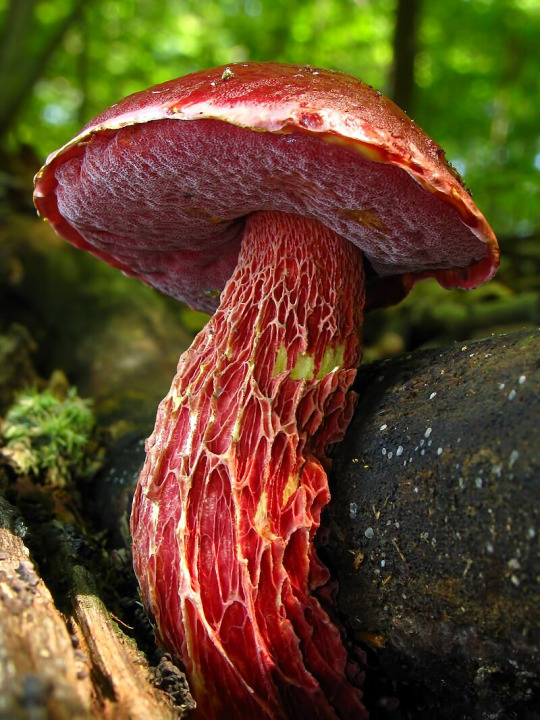
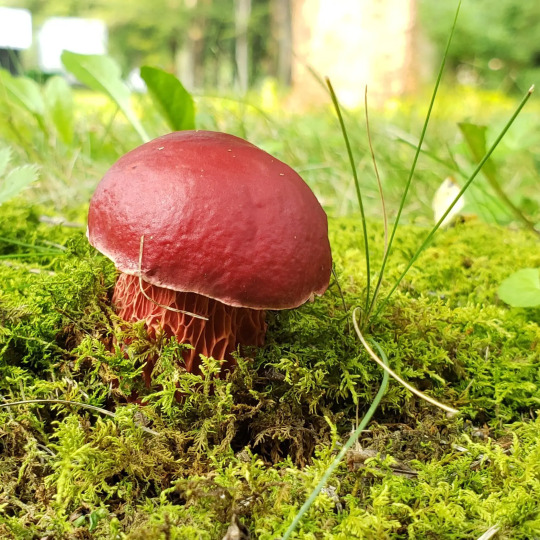
e. frostii description :
"the shape of the cap of the young fruit body ranges from a half sphere to convex, later becoming broadly convex to flat or shallowly depressed, with a diameter of 5–15 cm (2.0–5.9 in). the edge of the cap is curved inward, although as it ages it can uncurl and turn upward. in moist conditions, the cap surface is sticky as a result of its cuticle, which is made of gelatinized hyphae. if the fruit body has dried out after a rain, the cap is especially shiny, sometimes appearing finely areolate (having a pattern of block-like areas similar to cracked, dried mud). young mushrooms have a whitish bloom on the cap surface.
the colour is bright red initially, but fades with age. the flesh is up to 2.5 cm (1.0 in) thick, & ranges in colour from pallid to pale yellow to lemon yellow. the flesh has a variable staining reaction in response to bruising, so some specimens may turn deep blue almost immediately, while others turn blue weakly & slowly.
the tubes comprising the pore surface (the hymenium) are 9–15 mm deep, yellow to olivaceous yellow (mustard yellow), turning dingy blue when bruised. the pores are small (2 to 3 per mm), circular, & until old age a deep red colour that eventually becomes paler. the pore surface is often beaded with yellowish droplets when young (a distinguishing characteristic), & readily stains blue when bruised. the stipe is 4 to 12 cm (1.6 to 4.7 in) long, & 1 to 2.5 cm (0.4 to 1.0 in) thick at its apex. it is roughly equal in thickness throughout its length, though it may taper somewhat toward the top ; some specimens may appear ventricose (swollen in the middle). the stipe surface is mostly red, or yellowish near the base ; it is reticulate — characterized by ridges arranged in the form of a net-like pattern."
[images : source & source]
[fungus description : source]
234 notes
·
View notes
Text
FOTD #140 : nargan's bonnet! (mycena nargan)
nargan's bonnet (also spotted pixie cap) is a saprotrophic fungus in the family mycenaceae. it has been discovered across australia & tasmania, most notably in victoria :-) it is quite new to science, & was only discovered in the early 90s !!
the big question : can i bite it??
nah - the edibility is currently unknown.
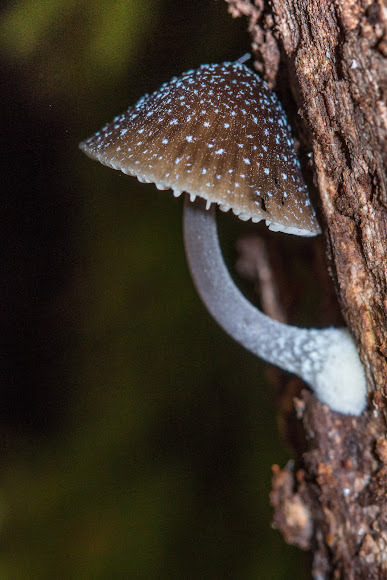

m. nargan description :
"the caps of young mushrooms are initially egg-shaped to conical, expanding to become bell-shaped & up to 2 cm (0.8 in) in diameter. initially, the margin of the cap is rolled inwards ; it typically assumes a lighter colour than the centre of the cap surface. dark brown in colour, the mushroom is distinguished by the presence of white speckles or scales on the cap and stem ; these scales may disappear when they become sloughed off or washed away by rain, which can make the species hard to recognise. the thick gills have an adnate attachment to the stem (broadly attached to the stem slightly above the bottom of the gill, with most of the gill fused to the stem), & are white to light grey in colour, paler toward the edge. there are about 24–28 gills extending completely from the cap margin to the stem, & one or two tiers of lamellulae (shorter gills does do not extend fully from the margin to the stem). the thin stem is up to 4 cm (1.6 in) high & 0.3 cm (0.12 in) wide, & does not have a ring. young specimens will typically have whitish scales at the base ; later, these will slough off & a felt-like whitish mycelium may be apparent."
[images : source & source]
[fungus description : source]
122 notes
·
View notes
Text
Finally finished my little mushroom guy. This ended up taking much longer than I anticipated but I think it turned out pretty alright.
812 notes
·
View notes
Text
FOTD #136 : field mushroom! (agaricus campestris)
the field mushroom (called the meadow mushroom in north america) is an agaric fungus in the family agaricaceae. this mycorrhizal species is often found in open fields & grassy areas worldwide :-) it often grows in small groups, or in fairy rings.
the big question : can i bite it??
absolutely - this mushroom is a choice edible !!
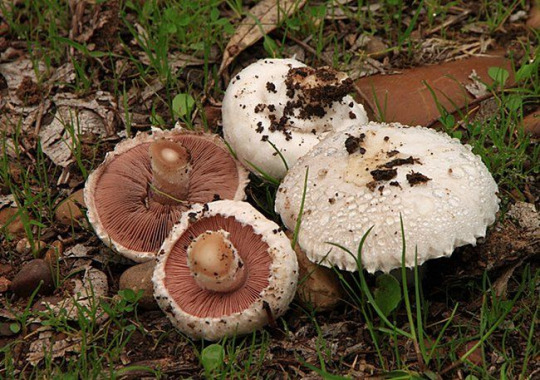

a. campestris description :
"the cap is white, may have fine scales, & is 3 to 12 centimetres (1+1⁄8 to 4+3⁄4 in) in diameter ; it is first hemispherical in shape before flattening out with maturity. the gills are initially pink, then red-brown & finally a dark brown, as is the spore print. the stipe is 3 to 10 cm (1+1⁄8 to 3+7⁄8 in) tall, 1–2 cm wide, predominantly white & bears a single thin ring."
[images : source & source]
[fungus description : source]
74 notes
·
View notes
Text
FOTD #135 : red-belted conk! (fomitopsis pinicola)
the red-belted conk is a polypore fungus in the family fomitopsidaceae :-) it is common throughout temperate zones in europe & asia. it produces brown rot & often parasitises rainforest trees.
the big question : can i bite it??
nah, it's inedible !!
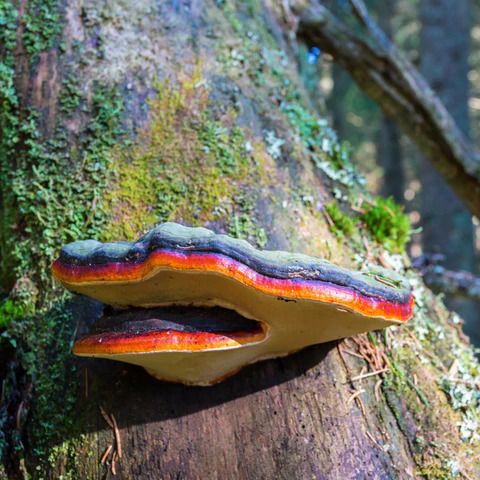

f. pinicola description :
"the cap is hoof-shaped or triangular, & sometimes shelflike. it is hard & tough, & up to 30 cm or more across & 15 cm thick. its surface is more or less smooth, at first orange-yellow with a white margin, later dark reddish to brown & then frequently with an orange margin. the pore surface is pale yellow to leather-brown, 3–4 pores per mm."
[images : source & source]
[fungus description : source]
124 notes
·
View notes






